Group Size
?
1.) Small group (teams of 4-6)
2.) Individual Task
3.) Large Group
4.) Any
Small group (teams of 4-6)
Learning Environment
?
1.) Lecture Theatre
2.) Presentation Space
3.) Carousel Tables (small working group)
4.) Any
5.) Outside
6.) Special
Special
QAA Enterprise Theme(s)
?
1.) Creativity and Innovation
2.) Opportunity recognition, creation and evaluation
3.) Decision making supported by critical analysis and judgement
4.) Implementation of ideas through leadership and management
5.) Reflection and Action
6.) Interpersonal Skills
7.) Communication and Strategy
1Creativity and Innovation
6Interpersonal Skills
On courses, students are often gaining skills in creativity and innovation but have no way of evidencing this in their future careers. The RGU Innovation Award was developed as an opportunity to certificate student innovation skills across three levels evolving from accredited course modules, to extra-curricular student challenges to individual innovation action plans. The process takes students from considering the future through to implementing an innovation idea.
The starting place for developing an extra-curricular programme is to engage a wide range of stakeholders across the university, including enterprise staff, careers colleagues, and staff across academic disciplines. At Robert Gordon University, the award was built on the former Scottish Innovative Student Award (SISA) hosted by Scottish Institute for Enterprise (SIE) and from the start, was intended to add value to existing activity as opposed to being seen as an audit. With the insight and buy in from a cross-university group – the next step was to define the framework for the award.
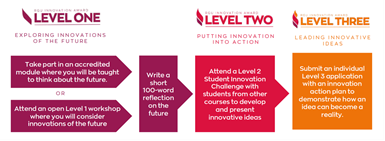
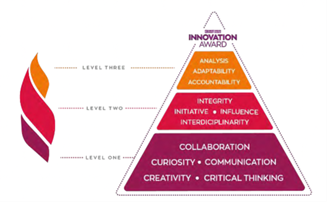
For us, this consisted of three levels:
Level 1 – Delivered either as part of existing modules or an extracurricular workshop where students needed to spend at least two hours exploring the future or innovation and evidence their competencies in communication, collaboration, curiosity, creativity, and critical thinking. After these two hours of delivery, students would need to apply for a certificate by writing a 100-word statement on ‘What is one prediction you have for an innovation which will shape the future of your industry and how do you think it might impact your career?’ this is reviewed by a central team before the certificates are issued.
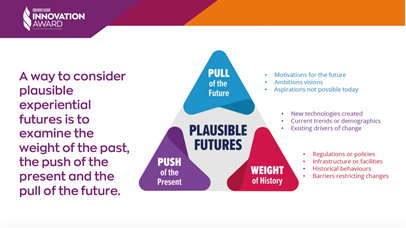
CONTENT EXAMPLE – During a Level 1 workshop, we put students into groups and they select an industry and consider the weight of the past, push of the present and pull of the future around that industry.
Level 2 – Any student who completes a Level 1 is invited to a Level 2 student innovation challenge workshop. These extracurricular events are interdisciplinary and bring students from difference courses together to solve a challenge set by an industry partner and aligned with the United Nations Sustainable Development Goals. The format is like a hackathon with the focus on working through the design thinking process in an afternoon with teams pitching innovative ideas to judges to win prizes. Through this stage the students develop competencies in taking initiative, having integrity, influencing and interdisciplinarity.
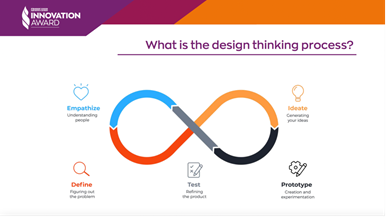
CONTENT EXAMPLE – During a Level 2 workshop, students are given a set persona related to the industry partner’s challenge and they need to work through the design thinking process to identify that persona’s pains, ideate potential solutions, narrow them down, sketch a prototype concept and test this with interviews with the industry partner’s in the room.
Level 3 – The final stage is an individual exercise where a student completes a two page action planning canvas to demonstrate their ability not just to have ideas, but to implement them. They need to reflect on why an idea is the best at solving a problem, what the risks are, what the financial implications may be and what the key steps to deliver the concept would be. This exercise demonstrates competencies in accountability, analysis, and adaptability.
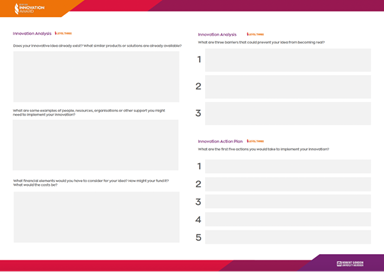
CONTENT EXAMPLE – The Level 3 worksheet is an editable canvas where students write their action plan. The design is intended to be like if they were making a proposal to a future employer about a new idea and the types of information they would need to include.
Once the framework is defined, you need to articulate it so that students and staff can understand the process. At Robert Gordon University we used our virtual learning environment to create a page for students and staff. For students this included an induction video, information on each level, and the links to submit or book onto a workshop and a certificate generator tool to automate the process. For staff, we had a separate page with information on the award, but also pre-made induction slides and guidance for submission slides they could easily drop into their materials. We also prepared a checklist document with links as a one-page guide for step-by-step what academic should do.
Finally, you will need to find a delivery model. For us, while we partnered with departments and colleagues across the university, the process was coordinated by our central Entrepreneurship and Innovation Group. A member of the team takes on responsibility for promoting and manging the process. When a new module wishes to be accredited to offer Level 1 certificates, they need to complete a short application on why their teaching activity achieves the competences and two hours of future thinking – this application is reviewed by one of our critical readers for approval. The central coordinating colleague manages this process, reviews Level 1 and 3 submissions, arranges the Level 1 and Level 2 open workshops, and works with student records to add the certificates to the student’s transcripts.
Through this process, in the first year alone, over 350 students have achieved a Level 1 award with 98 achieving Level 2 and 15 going on to achieve the Level 3. The award has been embedded across 90% of our academic schools and dozens of courses. Students who have been through the process have gone on to start companies or been accepted to our Startup Accelerator programme. The process continues to evolve with more subject areas engaging – but student feedback has been overwhelmingly positive – in particular when hosting face-to-face Level 1 and 2 workshop.
Keyur Shah, a Procurement and Supply Chain Management student who took part in a Level 2 workshop said “I thought the opportunity was a great way to connect students from various courses and mindsets. The inclusion of a real-life issue faced by a local business in Aberdeen is a unique way to engage in the out of the box thinking everybody was there to experience, and also for the business to gauge what the biggest trends in their field are among young people.”